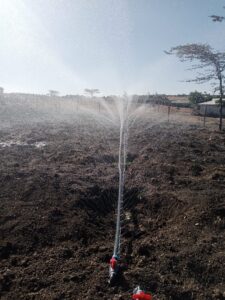
Rain Hose Irrigation System
Rain hose irrigation system with nanotechnology punched holes is an affordable irrigation system for overhead irrigation. Rain hose irrigation system uses nano technology to convey water to the plant. It has a series of holes spaced at intervals which sprays water flow by high gravity, or from a water pump is initiated. Our 0.5mm thick, 100M […]
One acre rain hose kits
Grekkon Limited’s one acre rain hose kits in Kenya installations are done by the technical team across the country. The number of rain hose pipes installed per acre is determined by the following:
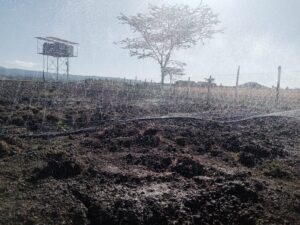
A one acre rain hose irrigation system installed by Grekkon Limited in Makutano area, laikipia county
- the available flow rate, and pumping pressure from the water pump or water source. Where the flow rate and pumping pressure is high, the diameter of reach is broad, so less rain hose pipes are needed
- the diameter of the pipes. Larger diameter rain hose pipes provide more water, over a larger area, so less of them are needed
Cost of one care rain hose kits in Kenya
| Diameter size | Flow rate per 100M | Price in KES |
| 32mm or 1″ | 13 cubic litres per hour | KES 85,000 |
| 40mm or 1-1/4” | 16 cubic litres per hour | KES 78,000 |
| 50mm to 1-1/2″ | 22 cubic litres per hour | KES 70,000 |
Rain hose pipes work under high gravity pressure (from 6M or 0.6bar), and with high volume water pumps. The discharge rate of the water pump is from 40 cubic litres per hour. These water pumps are surface solar, electric, petrol or diesel powered
One acre rain hose kits in Kenya
Installation
- Trench where the poly vinyl chloride (PVC) main line will be laid. This is not necessary for the high density polyethylene (HDPE) which are surface pipes. PVC pipes are sub-surface pipes because they have no UV-treatment, and will thus degrade easily under the sun. HDPE pipes have UV treatment and will be surface pipes
- Connect the PVC or (HDPE) main line to the water pump or high tank. This pipe evacuates water from the source to the farm and is the largest in diameter. The larger the pipe diameter, the more the water it delivers. .
- Join the HDPE or PVC sub-main line to the main line. The sub-main line is smaller in diameter, and so carries less water. It is joined to the main line through PVC or HDPE accessories such as; tees, elbows, saddle clamps, adaptors or valve sockets
- Connect the rain pipe to the sub-main line or the main line where a sub-main line does not exist. This is done with a rain hose connector or a saddle clamp
- Spread the rain hose along the length, and close the terminal end with an end cap
- Connect one rain pipe to another with a connector
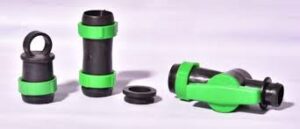
Rain hose fittings from left to right: end cap, connector, rubber, and ball valve
A drilling tool is the only tool used when installing a rain hose kit. This is to create an opening on the main or sub-main line to insert the rain pipe ball valve
One acre rain hose kits
Components of a rain hose irrigation kit?
1. End-caps. They close the end of the pipe to prevent further water flow 2. Starter off-takes. They connect the rain pipe to the PVC or HDPE main line that supplies water to the rain hose from a water pump or highly elevated water tank 3. Pipe connectors. To connect one rain hose pipe to another 4. Mini valves. To control water flow to the rain hose pipe
The diameter of the pipe are; 25mm, 32mm, 40mm and 50mm. A grower chooses the preferred size based on crop water needs and area of irrigation. For instance, a farmer with 1 acre of the crop will comfortably water with the volume delivered through a 32mm rain hose pipe.
Another grower with 5 acres will better irrigate with a 50mm rain hose pipe. An acre of crop uses 1,000 meters of 25mm, 800 meters of 32mm rain hose pipes, 600M of 40mm pipes, and 400M of 50mm pipes
One acre rain hose kits
Rain hose irrigation system requirements
- The system requires a pressure head of 30M, and above
- When using a water pump to power the rain hose irrigation kit, the discharge rate should be from 45 cubic litres per hour
- The rate of water discharge is determined by the diameter size, and number of pores on the rain pipe. For instance, a rain pipe with 5 holes per cluster discharges less water than the one with 7 holes in a cluster
- It irrigates in opposite directions at a radius of 3M for the 32mm pipe, 5M for the 40mm pipe, and 7M for the 50mm pipe
- The vertical height of this water jet is 1M
One acre rain hose kits
FAQs
a. What is the difference between a rain hose irrigation system and a sprinkler system?
- The technology. The rain pipe irrigation system is designed using nano technology
- The mode of spray. A sprinkler sprays its water in one direction, a rain hose pipe sprays in 3 directions (vertically, horizontally, and diagonally)
- Placement. A sprinkler is placed upright on the surface or sub-surface (for pop up sprinklers). A rain hose is laid on the ground
b. What is the pressure in a rain pipe?
The minimum operating pressure is 30M head / 3 bars
c. What is the spacing for rain hose irrigation?
The distance from one rain pipe to another is from 1.5M depending on the operating pressure, and pipe diameter
Grekkon limited is the largest supplier and installer of rain hose irrigation systems in Kenya, and in the east and central Africa region
How To Install Rain Hose Kits
Grekkon Limited’s manual on how to install rain hose kits in Kenya is an easy to read step by step guide. It details every aspect of rain pipe assembly in the farm to provide understanding to farmers. As the pioneer of rain hose kits in Kenya, we are keen to that farmers receive the full benefit of rain pipe irrigation
What is the price of a rain hose irrigation kit?
| Diameter size | Flow rate per 100M | Price in KES |
| 32mm or 1″ | 13 cubic litres per hour | KES 2,500 |
| 40mm or 1-1/4” | 16 cubic litres per hour | KES 5,800 |
| 50mm to 1-1/2″ | 22 cubic litres per hour | KES 6,800 |
Rain hose pipes work under high gravity pressure (from 6M or 0.6bar), and with high volume water pumps. The discharge rate of the water pump is from 40 cubic litres per hour. These water pumps are surface solar, electric, petrol or diesel powered

A well connected rain hose pipe
How To Install Rain Hose Kits
- Trench where the poly vinyl chloride (PVC) main line will be laid. This is not necessary for the high density polyethylene (HDPE) which are surface pipes. PVC pipes are sub-surface pipes because they have no UV-treatment, and will thus degrade easily under the sun. HDPE pipes have UV treatment and will be surface pipes
- Connect the PVC or (HDPE) main line to the water pump or high tank. This pipe evacuates water from the source to the farm and is the largest in diameter. The larger the pipe diameter, the more the water it delivers. .
- Join the HDPE or PVC sub-main line to the main line. The sub-main line is smaller in diameter, and so carries less water. It is joined to the main line through PVC or HDPE accessories such as; tees, elbows, saddle clamps, adaptors or valve sockets
- Connect the rain pipe to the sub-main line or the main line where a sub-main line does not exist. This is done with a rain hose connector or a saddle clamp
- Spread the rain hose along the length, and close the terminal end with an end cap
- Connect one rain pipe to another with a connector

Rain hose fittings from left to right: end cap, connector, rubber, and ball valve
A drilling tool is the only tool used when installing a rain hose kit. This is to create an opening on the main or sub-main line to insert the rain pipe ball valve
How to Install Rain Hose Kits
Components of a rain hose irrigation kit?
1. End-caps. They close the end of the pipe to prevent further water flow
2. Starter off-takes. They connect the rain pipe to the PVC or HDPE main line that supplies water to the rain hose from a water pump or highly elevated water tank
3. Pipe connectors. To connect one rain hose pipe to another
4. Mini valves. To control water flow to the rain hose pipe
The diameter of the pipe are; 25mm, 32mm, 40mm and 50mm. A grower chooses the preferred size based on crop water needs and area of irrigation. For instance, a farmer with 1 acre of the crop will comfortably water with the volume delivered through a 32mm rain hose pipe.
Another grower with 5 acres will better irrigate with a 50mm rain hose pipe. An acre of crop uses 1,000 meters of 25mm, 800 meters of 32mm rain hose pipes, 600M of 40mm pipes, and 400M of 50mm pipes
How To Install rain Hose Kits
Rain hose irrigation system requirements
- The system requires a pressure head of 30M, and above
- When using a water pump to power the rain hose irrigation kit, the discharge rate should be from 45 cubic litres per hour
- The rate of water discharge is determined by the diameter size, and number of pores on the rain pipe. For instance, a rain pipe with 5 holes per cluster discharges less water than the one with 7 holes in a cluster
- It irrigates in opposite directions at a radius of 3M for the 32mm pipe, 5M for the 40mm pipe, and 7M for the 50mm pipe
- The vertical height of this water jet is 1M
Rain Hose Versus Drip Irrigation
- Rain pipes irrigate in an overhead fashion, drip lines irrigate to the root zone
- Drip tapes are water efficient, rain hose kits require large water volume
- Rain pipes have a higher pressure requirement than drip pipes
- Drip lines have emitters, while rain hose kits have pores done with nano technology
- The discharge rate for drip lines is 1.2 to 4 litres per hour per emitter, while the rain hose pore’s is from 7 litres per hour per emitter
- The cost of a drip kit installation per acre is from Kes 100,000, while the rain hose is from Kes 75,000
- The rain hose pipe’s minimum diameter is 25mm/ 3/4″, while drip tape’s is 8mm
Advantages Of A Rain Hose
- water saving and cost effective
- It is easy to install, use and maintain
- Ran hose nanotechnology punched holes are less prone to clogging
- It is used in a broad range of crops
- Rain hose pipes are light and easy to move about
- It irrigates uniformly
- It works under both low gravity and high water pump pressure
Rain hose irrigation system is for the following areas and on these crops
- Crop nurseries; vegetables, fruit trees, forestry
- Short vegetable crops (knee-high and below); cabbage, lettuce, broccoli, kales, spinach, collards, broad beans, carrot, strawberry, and others
- Pasture; grass and legumes
When choosing the crop to irrigate using this method, consider its susceptibility to foliage fungal infections predisposed by leaf surface wetness. Tomato, potato, peppers, peas, green beans, and chili easily succumb to foliage fungal infections when overhead or a rain hose system is used for a long time
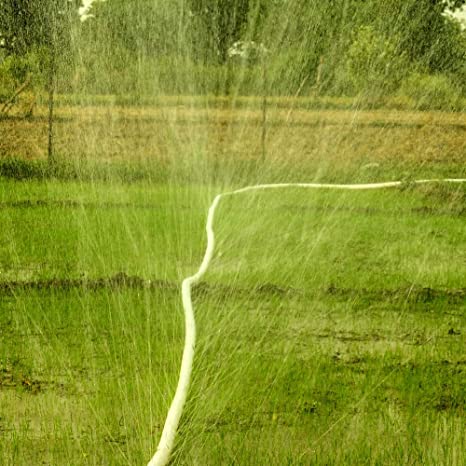
Pasture irrigation with a rain hose
How To Install Rain hose Kits
FAQs
a. What is the difference between a rain hose irrigation system and a sprinkler system?
- The technology. The rain pipe irrigation system is designed using nano technology
- The mode of spray. A sprinkler sprays its water in one direction, a rain hose pipe sprays in 3 directions (vertically, horizontally, and diagonally)
- Placement. A sprinkler is placed upright on the surface or sub-surface (for pop up sprinklers). A rain hose is laid on the ground
b. What is the pressure in a rain pipe?
The minimum operating pressure is 30M head / 3 bars
c. What is the spacing for rain hose irrigation?
The distance from one rain pipe to another is from 1.5M depending on the operating pressure, and pipe diameter
Grekkon limited is the largest supplier and installer of rain hose irrigation systems in Kenya, and in the east and central Africa region

Rain Hose Pipe Price
Grekkon Limited’s rain hose pipe price is by diameter size. Our rain hose for sale in Kenya is attached to a HDPE, PVC, or delivery/ lay-flat irrigation main or sub-main line when in the farm. These rain hose pipes are made from HDPE material with UV treatment for use in tropical climates.
Rain Hose Pipe Price Kenya
| Diameter size | Flow rate per 100M | Diameter of spray at 50M Head | Price in KES |
| 32mm or 1″ | 13 cubic litres per hour | 6M | KES 2,500 |
| 40mm or 1-1/4” | 16 cubic litres per hour | 8M | KES 3,500 |
| 50mm to 1-1/2″ | 22 cubic litres per hour | 9M | KES 4,500 |
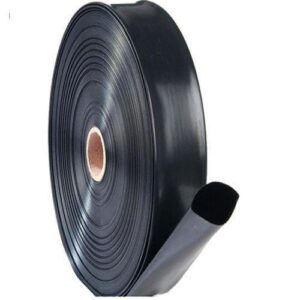
Rain Hose Pipe Price
Rain hose Vs drip irrigation
| Rain hose pipe | Drip irrigation pipe | |||||||
| 1 | Set up cost per acre is from Kes 45,000 | Set up cost per acre is from Kes 90,000 | ||||||
| 2 | Has holes punched with nano technology | Has a drip emitter | ||||||
| 3 | Has many holes per section | Has a single or double drip emitter per section | ||||||
| 4 | Irrigation rate is from 13 cubic litres per hour per 100M length | Irrigation rate is from 8.5 cubic litres per hour per 100M length | ||||||
| 5 | Has thicker (0.5mm) walls so lasts longer | Has thinner walls (0.3mm or 0.4mm) so a shorter lifespan | ||||||
| 6 | Diameter size is from 32mm to 50mm | Diameter size is 16mm | ||||||
| 7 | Maximum pipe length is 100M | Maximum pipe length is 1000M | ||||||
| 8 | Irrigates aerially using sprays | Irrigates to the ground via small drops |
| 9 | Easy to move from section to section in the farm | They are permanently set in one section |
The rain hose pipe price is not a good cost comparison to either drip or sprinkler irrigation. Rather, consider the set up and operational cost per acre under each method of irrigation Rain hose works well with crops that thrive under sprinkler irrigation. Examples are; onion, garlic, cabbage, traditional vegetables, leafy vegetables and others. Crops that are susceptible to fungal infections if the leaves remain wet for long are irrigated with drip. Examples are; green beans, potato, strawberry, tomato, capsicums, peppers and others
Rain Hose Pipe Price
What are the other components of a rain hose irrigation kit?
1. End-caps. They close the end of the pipe to prevent further water flow 2. Starter off-takes. They connect the rain pipe to the PVC or HDPE main line that supplies water to the rain hose from a water pump or highly elevated water tank 3. Pipe connectors. To connect one rain hose pipe to another 4. Mini valves. To control water flow to the rain hose pipe
The diameter of the pipe are; 25mm, 32mm, 40mm and 50mm. A grower chooses the preferred size based on crop water needs and area of irrigation. For instance, a farmer with 1 acre of the crop will comfortably water with the volume delivered through a 32mm rain hose pipe.
Another grower with 5 acres will better irrigate with a 50mm rain hose pipe. An acre of crop uses 1,000 meters of 25mm, 800 meters of 32mm rain hose pipes, 600M of 40mm pipes, and 400M of 50mm pipes
Rain Hose Pipe Price
Irrigation system requirements
- The system requires a pressure head of 30M, and above
- When using a water pump to power the rain hose irrigation kit, the discharge rate should be from 45 cubic litres per hour
- The rate of water discharge is determined by the diameter size, and number of pores on the rain pipe. For instance, a rain pipe with 5 holes per cluster discharges less water than the one with 7 holes in a cluster
- It irrigates in opposite directions at a radius of 3M for the 32mm pipe, 5M for the 40mm pipe, and 7M for the 50mm pipe
- The vertical height of this water jet is 1M
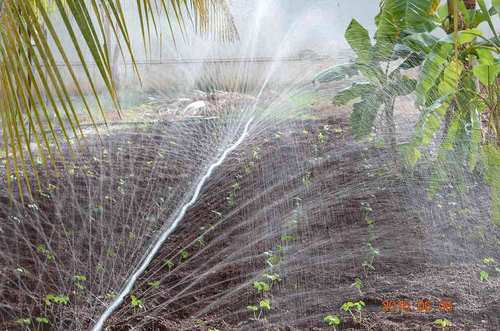
Irrigating a newly transplanted crop with a rain hose pipe
Rain Hose Pipe Price
How to assemble a rain hose irrigation system kit
1. Lay the mainline
This is the pipe delivering irrigation water to the farm from the pump. Your mainline will be larger in size than the rain hose pipe. So if your rain hose pipe is 1” for instance, use a 1.5” or 2″ main or sub mainline
2. Connect to the mainline
Make a 1” insertion on the mainline and attach the off-take connector. The size of the insertion is as per the size of your off-take3. Rain pipe connection
Attach the rain hose pipe to the off-take connector4. Hose to hose connection
Use the connector to attach one rain hose to another5. End cap
Insert the end cap at the end of the hose
Rain Hose Pipe Price
Target areas and crops
- Crop nurseries; vegetables, fruit trees, forestry
- Short vegetable crops (knee-high and below); cabbage, lettuce, broccoli, kales, spinach, collards, broad beans, carrot, strawberry, and others
- Pasture; grass and legumes
When choosing the crop to irrigate using this method, consider its susceptibility to foliage fungal infections predisposed by leaf surface wetness. Tomato, potato, peppers, peas, green beans, and chili easily succumb to foliage fungal infections when overhead or a rain hose system is used for a long time

Pasture irrigation with a rain hose
Rain Hose Irrigation Versus Drip Irrigation
- Rain pipes irrigate in an overhead fashion, drip lines irrigate to the root zone
- Drip tapes are water efficient, rain hose kits require large water volume
- Rain pipes have a higher pressure requirement than drip pipes
- Drip lines have emitters, while rain hose kits have pores done with nano technology
- The discharge rate for drip lines is 1.2 to 4 litres per hour per emitter, while the rain hose pore’s is from 7 litres per hour per emitter
- The cost of a drip kit installation per acre is from Kes 100,000, while the rain hose is from Kes 75,000
- The rain hose pipe’s minimum diameter is 25mm/ 3/4″, while drip tape’s is 8mm
Advantages Of Rain Hose Irrigation
- water saving and cost effective
- It is easy to install, use and maintain
- Ran hose nanotechnology punched holes are less prone to clogging
- It is used in a broad range of crops
- Rain hose pipes are light and easy to move about
- It irrigates uniformly
- It works under both low gravity and high water pump pressure

Rain Hose Pipe Price
FAQsa. What is the difference between a rain hose irrigation system and a sprinkler system?
- The technology. The rain pipe irrigation system is designed using nano technology
- The mode of spray. A sprinkler sprays its water in one direction, a rain hose pipe sprays in 3 directions (vertically, horizontally, and diagonally)
- Placement. A sprinkler is placed upright on the surface or sub-surface (for pop up sprinklers). A rain hose is laid on the ground
b. What is the pressure in a rain pipe?
The minimum operating pressure is 30M head / 3 barsc. What is the spacing for rain hose irrigation?
The distance from one rain pipe to another is from 1.5M depending on the operating pressure, and pipe diameterGrekkon limited is the largest supplier and installer of rain hose irrigation systems in Kenya, and in the east and central Africa region. It offres the most affordable rain hose pipe prices

